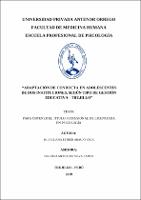Mostrar el registro sencillo del ítem
Adaptación de conducta en adolescentes de dos instituciones, según tipo de gestión educativa - Trujillo
| dc.contributor.advisor | Silva Ramos, Lidia Mercedes | |
| dc.contributor.author | Araujo Vega, Jhuliana Esther | |
| dc.creator | Araujo Vega, Jhuliana Esther | |
| dc.date.accessioned | 2019-06-07T16:55:37Z | |
| dc.date.available | 2019-06-07T16:55:37Z | |
| dc.date.issued | 2019 | |
| dc.identifier.uri | https://hdl.handle.net/20.500.12759/4924 | |
| dc.description.abstract | La presente investigación tuvo como objetivo comparar la Adaptación de Conducta en adolescentes de dos Instituciones, según tipo de Gestión Educativa, en alumnos de primero, segundo y tercer año de secundaria de un colegio Estatal y un Particular de Trujillo. La población total estuvo conformada por 774 alumnos, de ambos sexos, entre los 12 y 15 años de edad, de donde se obtuvo una muestra de 254 distribuida por 127 alumnos para cada institución educativa. Se trabajó con el diseño descriptivo – comparativo, recolectando la información con el Inventario de Adaptación de Conducta (IAC) de M.ª Victoria De La Cruz y Agustín Cordero (1990). Luego de realizar el análisis de los datos, se halló diferencias muy significativas en la adaptación de conducta Familiar y Social; sin embargo, no se encontró diferencias significativas en la adaptación de conducta Personal y Educativa. Se concluye que, con estos resultados se acepta parcialmente la hipótesis general, dado que existen diferencias muy significativas (p<.01) en la adaptación de conducta, siendo los adolescentes de institución educativa estatal que predominan el nivel medio (38.6%) de adaptación de conducta, por lo contrario, en la institución educativa privada predomina el nivel alto (37.8%). | es_PE |
| dc.description.abstract | The present investigation had the objective was to compare the Adaptation of Conduct in adolescents of two Institutions, according type of Education Management, in students of firstly, the second and third year of secondary of a State school and a Particular of Trujillo. The total population consisted of 774 students, of both sexes, between 12 and 15 years of age, from which a sample of 254 distributed by 127 students was obtained for each educational institution. We worked with the descriptive - comparative using the following instrument: Inventory of Adaptation of Conduct (IAC) of M. ª Victoria De La Cruz and Agustín Cordero (1990). After realizing the analysis of the data, one found very significant differences in the adaptation of conduct Family and Social; however, not significant differences were found in the adaptation of conduct Personal and Educational. It is concluded that, with these results, the general hypothesis is accepted partially, given that there are significant differences (p<.01) exist in the adaptation of conduct, being the adolescents of educational institutions State that predominate level (38.6%) on the contrary, in the educational institutions Private the high level predominates (37.8%). | en_US |
| dc.description.uri | Tesis | es_PE |
| dc.format | application/pdf | es_PE |
| dc.language.iso | spa | es_PE |
| dc.publisher | Universidad Privada Antenor Orrego - UPAO | es_PE |
| dc.relation.ispartofseries | T_PSICO_190 | |
| dc.rights | info:eu-repo/semantics/openAccess | es_PE |
| dc.source | Universidad Privada Antenor Orrego | es_PE |
| dc.source | Repositorio Institucional - UPAO | es_PE |
| dc.subject | Adaptación de conducta | es_PE |
| dc.subject | Adolescentes de secundaria | es_PE |
| dc.title | Adaptación de conducta en adolescentes de dos instituciones, según tipo de gestión educativa - Trujillo | es_PE |
| dc.type | info:eu-repo/semantics/bachelorThesis | es_PE |
| thesis.degree.level | Título Profesional | es_PE |
| thesis.degree.grantor | Universidad Privada Antenor Orrego. Facultad de Medicina Humana | es_PE |
| thesis.degree.name | Psicólogo | es_PE |
| thesis.degree.discipline | Psicología | es_PE |
Ficheros en el ítem
Este ítem aparece en la(s) siguiente(s) colección(es)
-
Psicología [439]

